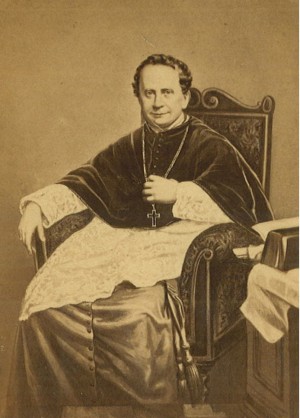As a volunteer at PAHRC this summer, I was tasked with labeling descriptions of letters from one of the journals of Bishop Francis Kenrick, who served as bishop of Philadelphia from 1830 until 1851. This particular journal, which Kenrick kept while in Philadelphia, has never been published or translated from the original Latin in which much of it was written. In addition to this journal, Kenrick also kept another journal known as his Diary and Visitation Record that provides an account of his Episcopal Visitations throughout the Diocese of Philadelphia. This journal was translated into English by Reverend Francis Tourscher and published in 1916.
After noting the page on which each letter started, I marked whether the letter was written in English or Latin, which was the primary language of correspondence used by clergy during this time period. In his journal, Kenrick alternated between drafting long letters to fellow clergymen and jotting down short descriptions of letters written elsewhere; however, the inclusion of dates and the repeat appearance of various names made the letters easy to locate.
Born in Dublin in December of 1797, Kenrick first came to the United States after completing his clerical studies in Rome in 1821 and served as a professor of theology and history in Kentucky for the next nine years. It was after attending the First Provincial Council of Baltimore in 1829 that Kenrick began his work in Philadelphia. During his twenty years in the city, Kenrick supported the building of asylums for young boys and girls and dozens of new churches throughout the diocese; wisely encouraged the establishment of a new diocese in Pittsburgh; and consented to the creation of the newspaper The Catholic Herald. Kenrick was succeeded by Bishop John Neumann in 1852 after Kenrick was named the Archbishop of Baltimore.
The early years of Kenrick's time in Philadelphia were not without controversy, and many of the letters at the beginning of his journal detail the events surrounding the conflict between the bishop and the trustees of St. Mary's Church, then the cathedral of Philadelphia. Named coadjutor bishop while Bishop Henry Conwell retained the title, Kenrick took pains to assert his authority amidst opposition from the trustees and even placed the cathedral under interdict for a short time. Bishop Kenrick's efforts contributed to a decline in the power of the trustees and to an increased sense of stability in a diocese that had been long divided by tensions arising from trusteeism.
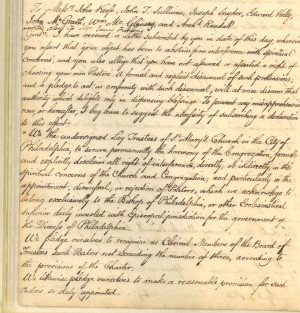
A letter written by Bishop Kenrick describing the conditions to which he hoped the lay trustees of St. Mary's would agree.
While Kenrick maintained in several of his letters that Masses and funeral services should continue to be said in Latin rather than in a vernacular language such as German, his letters reveal a concern for the growing population of German Catholics in his expansive diocese. It is clear from a letter written to Kenrick from the president of the Council of Lyon in 1843 that some missionaries of the time were concerned for the welfare of German Catholics in America (Correspondence 120). Bishop Kenrick provided money to aid a new German parish in Philadelphia (Nolan 252) and allowed for the publication of a Catholic newspaper in German.
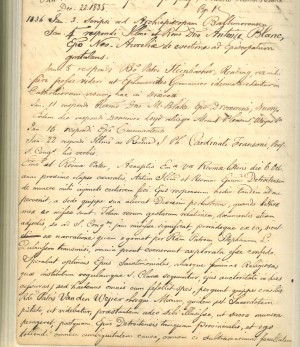
A page from Kenrick's journal that mentions the establishment of the Catholic newspaper for Germans.
It was also interesting to note that two of the letters mentioned in Bishop Kenrick's journal were written to Joseph Bonaparte, the older brother of Napoleon Bonaparte. In these letters Kenrick requests an image of St. Mary Magdalene and expresses his thanks for The Flagellation of Christ by Hannibal Carracci.
Perhaps most noteworthy was Bishop Kenrick's recognition of the importance of ensuring that the priests in his diocese were well-educated, and it was his welcoming of a young student named Patrick Bradley into his home that marked the establishment of what is today St. Charles Borromeo Seminary. Having such extensive experience as an educator, Kenrick taught his own students until his brother Peter arrived in 1834 and began to assist him. It seems fitting that a man so earnest in his desire to share his learning with others would refer to this particular endeavor as of the greatest “importance for the future of the Church” (qtd. in Nolan 187). The seminary continued to grow throughout Bishop Kenrick’s time in Philadelphia, especially after the Vincentians assumed control of its operations.
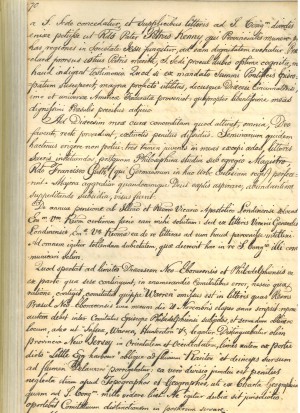
A letter from 1832 to Cardinal Pedicini in which Kenrick mentions the seminary, which was begun earlier that year.
Learning more about the bishop who was so integrally responsible for the founding and expansion of the seminary was especially intriguing as a volunteer here. It is fortunate that Kenrick was so meticulous in keeping records of his life, since we are now able to use these records of his letters and travels to gain a deeper understanding of the Diocese of Philadelphia during a time of both hardships and great advances. The journal with which I worked offers insight into Kenrick’s personal relationships with other clerical officials, while his visitation journal details his travels throughout Pennsylvania and reveals him to be a man deeply interested in the spiritual well-being of the Catholics living in his diocese.
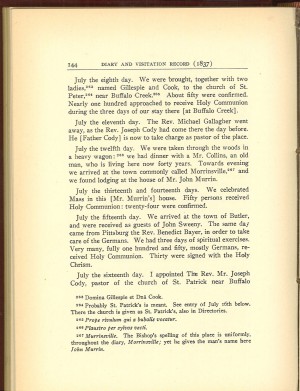
A typical page from Kenrick's Visitation Records that shows the bishop's concern with administering the sacraments to Catholics throughout the diocese.
This journal that Bishop Kenrick kept between 1830 and 1851 during his time in Philadelphia, as well as translations of many of his letters and of his diary and visitation records, can all be found here at the Historical Research Center. A summary and brief description of the main entries in Kenrick's journal is also available here at PAHRC.
References
Kenrick, Francis Patrick. Diary and Visitation Record of the Rt. Rev. Francis Patrick Kenrick, Administrator and Bishop of Philadelphia, 1831-1852, Later Archbishop of Baltimore. Trans. Francis Edward Tourscher. Lancaster: Wickersham Printing Co., 1916.
The Kenrick-Frenaye Correspondence: Letters chiefly of Francis Patrick Kenrick and Marc Antony Frenaye Selected from the Cathedral Archives, Philadelphia. Trans. Francis Edward Tourscher. Philadelphia: Wickersham Printing Company, 1920.
Looby, John. “Francis Patrick Kenrick.” Edited Appleton’s Enyclopedia. Virtualology, 2001. <http://famousamericans.net/francispatrickkenrick/>.
Nolan, Hugh J. Francis Patrick Kenrick: Third Bishop of Philadelphia. Philadelphia: American Catholic Historical Society of Philadelphia, 1948.
O'Shea, John J. "Francis Patrick and Peter Richard Kenrick." The Catholic Encyclopedia. Vol. 8. New York: Robert Appleton Company, 1910. <http://www.newadvent.org/cathen/08618a.htm>.


